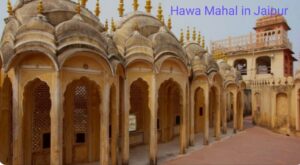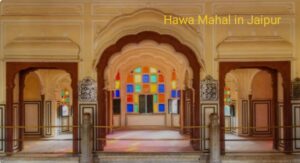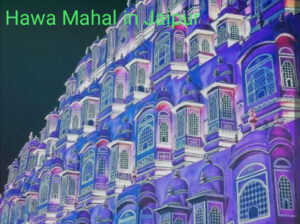Hawa Mahal in Jaipur the heart of the Pink City, Jaipur, the Hawa Mahal stands as a testament to the city’s rich cultural heritage and architectural ingenuity. This iconic monument, also known as the “Palace of Winds,” is one of Jaipur’s most renowned landmarks, attracting tourists from around the globe. In this blog post, we will explore the history, architecture, cultural significance, and visitor experience of Hawa Mahal, offering a comprehensive guide to one of India’s most captivating structures.

1. Hawa Mahal in Jaipur:History of Hawa Mahal
The Hawa Mahal was constructed in 1799 by Maharaja Sawai Pratap Singh, a ruler of Jaipur from the Kachwaha Rajput dynasty. Designed by Lal Chand Ustad, this five-story structure was built primarily to allow the royal ladies to observe everyday life and festivities on the streets without being seen, in line with the strict Purdah system. The unique design of the palace, with its small windows and screened balconies, provided privacy while ensuring a constant flow of cool air, giving the palace its name, “Hawa Mahal.”
2.Hawa Mahal in Jaipur: Architectural Marvel
The Hawa Mahal is renowned for its distinctive honeycomb-like facade, which features 953 small windows, or jharokhas, adorned with intricate latticework. The red and pink sandstone structure is an epitome of Rajputana architecture, with its blend of Hindu and Islamic styles. The palace’s pyramid shape rises to a height of 15 meters, with each floor diminishing in size from the bottom to the top. Inside, the palace consists of chambers with arched roofs, corridors, and pillars, all designed to enhance ventilation and keep the interiors cool.

3. Hawa Mahal: Cultural and Historical Significance
Hawa Mahal holds immense cultural and historical significance as a symbol of Jaipur’s royal heritage. It played a crucial role in the lives of the royal women, who could enjoy the hustle and bustle of the city from the palace’s windows without compromising their privacy. The palace also reflects the socio-cultural norms of the time, showcasing the architectural brilliance and thoughtful design that catered to the needs of the royal family.
4.Visitor Experience
Visiting Hawa Mahal is a unique experience that transports you back to the grandeur of the Rajput era. The best time to visit is early in the morning when the sunlight bathes the palace in a golden hue. The monument is open to visitors from 9:00 AM to 4:30 PM, with a nominal entry fee. Guided tours are available, offering valuable insights into the history and architecture of the palace. Nearby attractions such as the City Palace and Jantar Mantar make it easy to explore the rich heritage of Jaipur in one trip.

5.Preservation and Conservation Efforts
Over the years, Hawa Mahal has undergone several restoration projects to preserve its structural integrity and aesthetic appeal. The Archaeological Survey of India (ASI) and various non-governmental organizations have played a significant role in these conservation efforts. Maintaining such historical monuments is vital to preserving the cultural heritage and history for future generations.
6.Hawa Mahal in Popular Culture
Hawa Mahal has left an indelible mark on popular culture, appearing in numerous films, literature, and media. Its unique design and historical significance have inspired artists, writers, and filmmakers, making it a popular subject in postcards, souvenirs, and local crafts. The palace’s charm continues to captivate the imagination of people around the world.
7.Travel Tips
To make the most of your visit to Hawa Mahal, here are some useful travel tips:
– How to Reach: Hawa Mahal is centrally located in Jaipur and is easily accessible by local transport, including auto-rickshaws, taxis, and buses.
– What to Wear: Dress comfortably, preferably in light clothing, and wear comfortable shoes as you’ll be walking around the palace.
– Photography: While photography is allowed, be mindful of the surroundings and avoid using flash inside the palace.
– Nearby Eateries and Shops: After exploring Hawa Mahal, you can enjoy local Rajasthani cuisine at nearby restaurants and shop for souvenirs in the bustling markets around the palace.
Conclusion:
Hawa Mahal is not just a palace; it is a symbol of Jaipur’s rich cultural heritage and architectural brilliance. Its intricate design, historical significance, and the royal charm make it a must-visit destination for anyone exploring the Pink City. Whether you’re a history enthusiast, an architecture lover, or a curious traveler, Hawa Mahal promises an unforgettable experience.
FAQ:
1.Why Hawa Mahal is famous in Jaipur?
2.What is inside Hawa Mahal?
3.Who lived in Hawa Mahal?
4.Why Hawa Mahal is called Hawa Mahal
5.History of Hawa Mahal
6.How many windows are there in Hawa Mahal
7.Importance of Hawa Mahal
8.Hawa Mahal photos
9.Hawa Mahal – wikipedia


Pingback: Gol Gumbaz: The Architectural Marvel of Bijapur - solotraveler